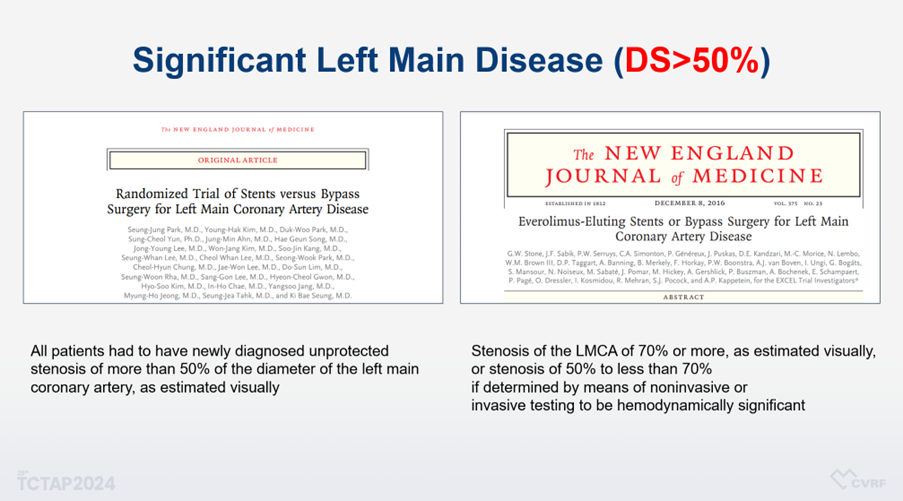
Do-Yoon Kang
Asan Medical Center, Republic of Korea
A recent lecture by Do-Yoon Kang, MD, at TCTAP 2024, °ģLeft Main and Multi-Vessel Diseases: Updated Concept and Treatment°Į elucidated the evolving landscape of diagnosing and treating significant stenosis in Left main coronary artery (LMCA) disease.
The definition of a significant left main disease varies, with thresholds set by major trials, such as the PRECOMBAT and EXCEL trials (Figure 1). While the PRECOMBAT trial identified significant disease at a threshold of 50% in terms of diameter stenosis, as estimated visually, the EXCEL trial defined significant stenosis as 70%, incorporating functional assessments for diameter stenosis between 50% and 70%. Some past trials have shown surgical benefits for patients with left main disease with a diameter stenosis of over 50% or 70%. However, challenges persist due to the poor reproducibility of angiographic analysis in assessing LMCA stenosis. In turn, intracoronary imaging combined with fractional flow reserve (FFR) has been offered as a solution, with data supporting its use in equivocal cases. Also, the 2018 ESC guideline recommends considering intravascular ultrasound (IVUS) to assess the severity of unprotected left main lesions. Meanwhile, discrepancies remain in FFR and IVUS-minimal luminal area (MLA) in intermediate LMCA stenosis.

In this clinical context, the upcoming FATE-MAIN (Fractional Flow Reserve versus Angiography for Treatment-Decision and Evaluation of Significant Left Main Coronary Artery Disease) trial was announced, comparing outcomes of FFR-guided percutaneous coronary interventions (PCI) against angiography-guided interventions (Figure 2). The study aims to enroll 934 patients, and the primary endpoint will be the composite of death from any causes, myocardial infarction, or hospitalization for unstable angina, heart failure, resuscitated cardiac arrest, or repeat revascularization at 2 years.
The lecture concluded with a message that achieving complete functional revascularization is important, and for all borderline or intermediate LMCA disease it is strongly recommended to confirm physiologic lesion significance before treatment using FFR evaluation. It is anticipated that FATE-MAIN will show better patient outcomes with FFR-guided PCI by avoiding unnecessary interventions.

TCTAP Workshops
Left Main and Multi-Vessel Diseases: Updated Concept and Treatment
Thursday, April 25, 2:00 PM ~ 3:50 PM
Valve & Endovascular Theater, Level 2
Edited by

Hoyun Kim, MD
Bucheon Sejong Hospital, Korea (Republic of)
